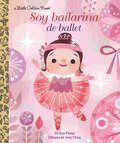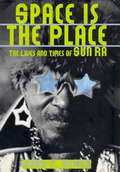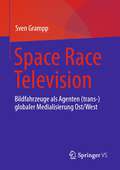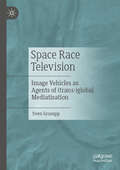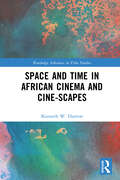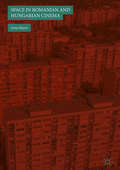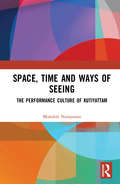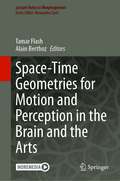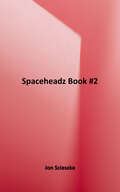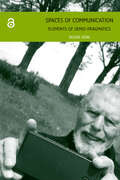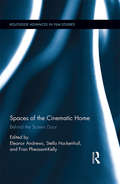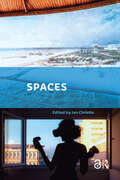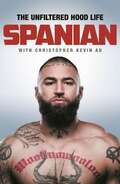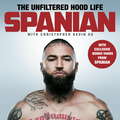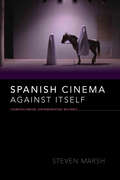- Table View
- List View
Sovereign Screens: Aboriginal Media on the Canadian West Coast
by Kristin L. DowellWhile Indigenous media have gained increasing prominence around the world, the vibrant Aboriginal media world on the Canadian West Coast has received little scholarly attention. As the first ethnography of the Aboriginal media community in Vancouver, Sovereign Screens reveals the various social forces shaping Aboriginal media production including community media organizations and avant-garde art centers, as well as the national spaces of cultural policy and media institutions.Kristin L. Dowell uses the concept of visual sovereignty to examine the practices, forms, and meanings through which Aboriginal filmmakers tell their individual stories and those of their Aboriginal nations and the intertribal urban communities in which they work. She explores the ongoing debates within the community about what constitutes Aboriginal media, how this work intervenes in the national Canadian mediascape, and how filmmakers use technology in a wide range of genres—including experimental media—to recuperate cultural traditions and reimagine Aboriginal kinship and sociality. Analyzing the interactive relations between this social community and the media forms it produces, Sovereign Screens offers new insights into the on-screen and off-screen impacts of Aboriginal media.
Sovereign Violence: Ethics and South Korean Cinema in the New Millennium (Film Culture in Transition)
by Steve ChoeSouth Korea is home to one of the most vibrant film industries in the world today, producing movies for a strong domestic market that are also drawing the attention of audiences worldwide. This book presents a comprehensive analysis of some of the most well-known and incendiary South Korean films of the millennial decade from nine major directors. Building his analysis on contemporary film theory and philosophy, as well as interviews and other primary sources, Steve Choe makes a case that these often violent films pose urgent ethical dilemmas central to life in the age of neoliberal globalization.
Soviet Film Music (Contemporary Music Studies)
by Tatiana EgorovaFirst Published in 1998. Routledge is an imprint of Taylor & Francis, an informa company.
Soy Bailarina de Ballet (Little Golden Book)
by Sue FliessUn libro en rima, entre los más vendidos de los Little Golden Books, acerca de una pequeña niña que estudia ballet — ¡ahora en español!Únete al regocijo de una niña que va a clase de ballet y luego participa en su primer recital. Un libro rimado y divertido, perfecto para ser leído en voz alta, con encantadoras ilustraciones que deleitarán a los niños. ¡Un regalo estupendo para todos los pequeños que disfrutan de la danza! A rhyming best-selling Little Golden Book about a young girl learning ballet--now in Spanish!Join in on the fun as a young girl goes to ballet class and then performs in her very first recital. This rhyming Little Golden Book is a fun read-aloud with delightful art that children will really enjoy. Makes a terrific gift for all young dancers!
Soy lo que soy
by Oswaldo CattoneLa autobiografía de uno de los hombres más queridos e influyentes del teatro peruano Cuando empezó la cuarentena sanitaria en 2020 y las salas de teatro se cerraron, Osvaldo Cattone se las ingenió para mantener encendido su espíritu creador. Durante ese año se dio a la tarea de compendiar sus recuerdos más entrañables. El resultado es esta apasionante autobiografía que cifra una existencia consagrada al mundo del espectáculo. Soy lo que soy es un aleccionador y ameno recuento de una vida tocada por el duende de la vocación artística. Un recorrido por los tres países que lo acogieron, formaron y aplaudieron —Argentina, Italia y Perú—, y donde Cattone desarrolló una destacada carrera como actor, director, productor y empresario. Décadas de entrega profesional que hoy constituyen uno de los capítulos esenciales en la historia del teatro peruano. En estas ejemplares memorias, escritas a sus 87 años, Cattone celebra y agradece su vida, al tiempo que se despide de ella con la alegría y la lucidez que siempre lo acompañaron
Sozioautobiographie und szenische Künste: Performative Suchbewegungen in einer offenen Gattung (Abhandlungen zur Literaturwissenschaft)
by Raffael HidenGesellschaftsdiagnosen durchkreuzen die Soziologiegeschichte in sehr unterschiedlichen Formen. Während sich geschichtsphilosophische Traditionslinien weitestgehend verflüchtigt haben, bestimmen aktuell interdisziplinäre und intermediale Experimentierfelder das Geschäft der Gesellschaftsdiagnose. Gegenwärtig wird diese Gattung mit performativen Instrumentarien erweitert, die im Zusammenhang stehen mit 'sozioautobiographischen' Schreibweisen . Gesellschaft wird hier zusehends mit dem Aufzug von Figuren und figurativen Darstellungsmodi an der Schnittstelle von Autobiographie und soziologischer Reflexion verhandelt. Dieser Band nimmt sich dieser Konjunktur an und versammelt Beiträge zur aktuellen Tendenz der szenischen Adaption bzw. Neuausrichtung dieser Stoffe, die anhand exemplarischer Fallbeispiele (u.a. Elfriede Jelinek, Milo Rau, Kim de l'Horizon) dargelegt werden.
Space Between: Explorations of Love, Sex, and Fluidity
by Nico TortorellaYounger star and LGTBQIA+ advocate Nico Tortorella investigates love, sex, gender, addiction, family, fame, and fluidity through their personal story and the lens of their nonbinary identity “Nico Tortorella embodies the twenty-first-century human.”—RuPaulNico Tortorella is a seeker. Raised on a steady regimen of Ram Dass and raw food, they have always been interested in the more spiritual aspects of life. That is, until the desire for fame and fortune eclipsed their journey toward enlightenment and sent them into a downward spiral of addiction and self-destructive behavior. It wasn’t until Nico dug deep and began to examine the fluidity of both their sexuality and gender identity that they became more comfortable in their own skin, got sober from alcohol, entered into an unconventional marriage with the love of their life, and fully embraced a queer lifestyle that afforded them the opportunity to explore the world outside the gender binary. It was precisely in that space between that Nico encountered the diverse community of open-minded, supportive peers they’d always dreamed of having. Expanding on themes explored on their popular podcast, The Love Bomb, Nico shares the intimate details of their romantic partnerships, the dysfunction of their loud but loving Italian family, and the mingling of their feminine and masculine identities into one multidimensional, sexually fluid, nonbinary individual. Nico has become a leading voice of the fluidity movement by encouraging open dialogue and universal acceptance. Space Between is at once an education for readers, a manifesto for both the labeled and label-free generations, and a personal memoir of love, identity, and acceptance.Praise for Space Between“In an industry that thrives on artifice, Nico Tortorella’s candid soul-searching is precious and invigorating. As with the best truth-telling, it gives language to a thirst we had forgotten, while also quenching it. This is a book about addiction, familial trauma, and gender—yes—but more so it is about living. Living is an art form that Nico does well, and this book is an argument for making meaning from the messiness that surrounds us rather than simply muting it. Nico’s distinct and relatable prose tangos us past binaries, toward an intimacy beyond language.”—Alok Vaid-Menon
Space Is the Place
by John F. SzwedAlways riveting, Space Is the Place is the definitive biography of "one of the great big-band leaders, pianists, and surrealists of jazz" (New York Times)--unparalleled for his purposeful outlandishness, a man who exerted a powerful influence over a vast array of artists.Sun Ra--a/k/a Herman Poole "Sonny Blount--was born in Alabama on May 22, 1914. But like Father Divine and Elijah Muhammad, he made a lifelong effort to obscure many of the facts of his early life. After years as a rehearsal pianist for nightclub revues and in blues and swing bands, including Wynonie Harris's and Fletcher Henderson's, Sun Ra set out in the 1950s to find a way to impart his views about the galaxy, black people, and spiritual matters through the various incarnations of the Intergalactic Arkestra. His repertoire ranging from boogie-woogie, swing, and bebop to free form, fusion, and whatever, Sun Ra was above all a paragon of contradictions: profundity and vaudeville; technical pianistic virtuosity and irony; assiduous attention to arrangements and encouragement of collective improvisation; respect for tradition and celebration of the fresh.Some might have been bemused by his Afro-Platonic neo-hermeticism; others might have laughed at his egregious excesses. But Sun Ra was at once one of the great avant-gardists of the latter half of the twentieth century and a black cultural nationalist who extended Afrocentrism from ancient Egypt to the heavens.
Space Odyssey: Stanley Kubrick, Arthur C. Clarke, and the Making of a Masterpiece
by Michael BensonThe definitive story of the making of 2001: A Space Odyssey, acclaimed today as one of the greatest films ever made, and of director Stanley Kubrick and writer Arthur C. Clarke—&“a tremendous explication of a tremendous film….Breathtaking&” (The Washington Post).Fifty years ago a strikingly original film had its premiere. Still acclaimed as one of the most remarkable and important motion pictures ever made, 2001: A Space Odyssey depicted the first contacts between humanity and extraterrestrial intelligence. The movie was the product of a singular collaboration between Stanley Kubrick and science fiction visionary Arthur C. Clarke. Fresh off the success of his cold war satire Dr. Strangelove, Kubrick wanted to make the first truly first-rate science fiction film. Drawing from Clarke&’s ideas and with one of the author&’s short stories as the initial inspiration, their bold vision benefited from pioneering special effects that still look extraordinary today, even in an age of computer-generated images. In Space Odyssey, author, artist, and award-winning filmmaker Michael Benson &“delivers expert inside stuff&” (San Francisco Chronicle) from his extensive research of Kubrick&’s and Clarke&’s archives. He has had the cooperation of Kubrick&’s widow, Christiane, and interviewed most of the key people still alive who worked on the film. Drawing also from other previously unpublished interviews, Space Odyssey provides a 360-degree view of the film from its genesis to its legacy, including many previously untold stories. And it features dozens of photos from the making of the film, most never previously published. &“At last! The dense, intense, detailed, and authoritative saga of the making of the greatest motion picture I&’ve ever seen…Michael Benson has done the Cosmos a great service&” (Academy Award-winning actor Tom Hanks).
Space Race Television: Bildfahrzeuge als Agenten (trans-)globaler Medialisierung Ost/West
by Sven GramppDer Band bietet eine medientheoretisch ausgerichtete Perspektive auf das Space Race. Analysiert werden Spielfilme, Dokumentationen, Live-Berichterstattung im Fernsehen, Magazine, Briefmarken, Plakate, Konfettiparaden, die das Space Race in je spezifischer Weise ins Bild setzten und von ‚Ost‘ nach ‚West‘ und von ‚West‘ nach ‚Ost‘ transnational über den ‚Eisernen Vorhang‘ hinweg in Umlauf brachten. Gezeigt wird, wie sich die Berichterstattung über das Space Race dabei zwischen 1955 und 1975 als globalisierende Bilder-Verflechtungsgeschichte während des Kalten Krieges nacherzählen lässt.
Space Race Television: Image Vehicles as Agents of (trans-)global Mediatisation
by Sven GramppThis volume offers a media-theoretically oriented perspective on the Space Race. It analyzes feature films, documentaries, live television coverage, magazines, stamps, posters, ticker-tape parades. They visualized the Space Race in a specific way and circulated it transnationally from 'East' to 'West' and from 'West' to 'East' across the 'Iron Curtain'. It will be shown how reporting on the Space Race between 1955 and 1975 can be explained as a globalizing history of the intertwining of images during the Cold War.
Space and Time in African Cinema and Cine-scapes (Routledge Advances in Film Studies)
by Kenneth W. HarrowThis book is the first of its kind to bring basic notions of contemporary physics to bear on African cine-scapes. In this book, renowned African cinema scholar Kenneth W. Harrow presents unique new ways to think about space and time in film, with a specific focus on African and African diasporic cinema. Through a series of case studies, he explores how cinema creates and represents time and space and, more specifically, how a cinema centered in African landscapes and figures accomplishes this. He reflects on the issues and problems posed by scientists when faced with the basic questions of what space and time are and their solutions or conclusions, giving both film studies and African studies scholars access to new ways to formulate their thinking about African cine-scapes. Working beyond the limits of a framework based in a postcolonial and cultural understanding of time and space, Harrow demonstrates how a scientific understanding of time and space can open up new approaches to African cinema and cinema in general. A unique, interdisciplinary book that encourages brand new ways to approach cinematic texts and, specifically, African cine-scapes.
Space in Romanian and Hungarian Cinema
by Anna BatoriThis book examines the structuring of space in Romanian and Hungarian cinema, and particularly how space is used to express the deep imprint of a socialist past on a post-socialist present. It considers this legacy of the Eastern European socialist regimes by interrogating the suffocating, tyrannical and enclosing structures that are presented in film. By tracing such paradigmatic models as horizontal and vertical enclosure, this book aims to show how enclosed spatial structuring restages the post-socialist era to produce an implicit and collective form of remembrance. While closely scrutinizing the interplay of location and image, Space in Romanian and Hungarian Cinema offers a new approach to the cinema of the region, which unites the filmic productions under a defined, post-socialist Eastern European spatial umbrella. By simultaneously portraying the gloom of a socialist past, while also conveying a sense of longing for a pre-capitalist era, these films convey how sense of unity and also ambivalence is a defining hallmark of Eastern European cinema.
Space, Time and Ways of Seeing: The Performance Culture of Kutiyattam
by Mundoli NarayananThis volume explores the constitutive role played by space in the performance of Kutiyattam. The only surviving form of Sanskrit theatre, Kutiyattam is distinctive in terms of its performance conventions and its unique culture of extensive elaboration and interpretation. Drawing upon the concepts of phenomenology on the processes of perception, particularly on the works of Edmund Husserl, Martin Heidegger and Maurice Merleau-Ponty, it analyses the role of space in the communicative structures of performance of Kutiyattam and its contribution to the production of meaning in theatre, especially in the context of contemporary theatre. The book explores the theatrical event as a phenomenon that comes into existence through a triangular relationship among the ‘ways of being’ of the performers, the ‘ways of seeing’ of the audience, and the space which brings them together. Based on this formulation, Kutiyattam is approached as a ‘theatre of elaboration,’ made possible by the ‘intimate,’ ‘proximal’ ways of seeing of the audience, in the particular theatrical space of the kūttampalaṃs, the temple theatres, where Kutiyattam has customarily been performed for more than five centuries. This volume will be of great interest to scholars and researchers of cultural studies, theatre and performance studies, cultural anthropology, phenomenology and South Asian studies.
Space-Time Geometries for Motion and Perception in the Brain and the Arts (Lecture Notes in Morphogenesis)
by Alain Berthoz Tamar FlashThis book is based on a two-day symposium at the Paris Institute of Advanced Study titled "space-time geometries and movement in the brain and the arts". It includes over 20 chapters written by the leading scientists and artists who presented their related research studies at the symposium and includes six sections; the first three focus on space-time geometries in perception, action and memory while the last three focus on specific artistic domains: drawing and painting, dance, music, digital arts and robotics. The book is accompanied by a dedicated webpage including related images and videos. There is an ever-growing interest in the topics covered by this book. Space and time are of fundamental importance for our understanding of human perception, action, memory and cognition, and are entities which are equally important in physics, biology, neuroscience and psychology. Highly prominent scientists and mathematicians have expressed their belief that our bodies and minds shape the ways we perceive space and time and the physical laws we formulate. Understanding how the brain perceives motion and generates -bodily movements is of great significance. There is also growing interest in studying how space, time and movement subserve artistic creations in different artistic modalities (e.g., fine arts, digital and performing arts and music). This interest is inspired by the idea that artists make intuitive use of the principles and simplifying strategies used by the brain in movement generation and perception. Building upon new understanding of the spatio-temporal geometries subserving movement generation and perception by the brain we can start exploring how artists make use of such neuro --geometrical and neuro-dynamic representations in order to express artistic concepts and emotionally affect the human observers and listeners. Scientists have also started formulating new ideas of how aesthetic judgements emerge from the principles and brain mechanisms subserving motor control and motion perception.Covering novel and multidisciplinary topics, this advanced book will be of interest to neuroscientists, behavioral scientists, artificial intelligence and robotics experts, students and artists.
Spaceheadz Book #2! (Spaceheadz Ser. #2)
by Jon ScieszkaThe campaign to save the earth from being turned off is going well, but Michael K. must enlist fellow fifth-graders Venus and TJ to help hide the SPHDZ from Agent Umber, especially when they become involved in a school play.
Spaces Mapped and Monstrous: Digital 3D Cinema and Visual Culture (Film and Culture Series)
by Nick JonesDigital 3D has become a core feature of the twenty-first-century visual landscape. Yet 3D cinema is a contradictory media form: producing spaces that are highly regimented and exhaustively detailed, it simultaneously relies upon distortions of vision and space that are inherently strange.Spaces Mapped and Monstrous explores the paradoxical nature of 3D cinema to offer a critical analysis of an inescapable part of contemporary culture. Considering 3D’s distinctive visual qualities and its connections to wider digital systems, Nick Jones situates the production and exhibition of 3D cinema within a web of aesthetic, technological, and historical contexts. He examines 3D’s relationship with computer interfaces, virtual reality, and digital networks as well as tracing its lineage to predigital models of visual organization. Jones emphasizes that 3D is not only a technology used in films but also a tool for producing, controlling, and distorting space within systems of surveillance, corporatization, and militarization. The book features detailed analysis of a wide range of films—including Avatar (2009), Goodbye to Language (2014), Love (2015), and Clash of the Titans (2010)—demonstrating that 3D is not merely an augmentation of 2D cinema but that it has its own unique properties. Spaces Mapped and Monstrous brings together media archaeology, digital theory, and textual analysis to provide a new account of the importance of 3D to visual culture today.
Spaces of Communication: Elements of Semio-Pragmatics (Film Theory in Media History)
by Roger OdinSpaces of Communication offers a concise introduction to semiopragmatics and condenses the intellectual trajectory of one of the foundational figures of film studies into a relatively short and accessible volume. It testifies to the author’s deep and rich intellectual engagement with a vast array of objects ranging from the classics of the cinephile canon to television news programs, home movies and mobile phone films.
Spaces of the Cinematic Home: Behind the Screen Door (Routledge Advances in Film Studies #42)
by Stella Hockenhull Eleanor Andrews Fran Pheasant-KellyThis book examines the ways in which the house appears in films and the modes by which it moves beyond being merely a backdrop for action. Specifically, it explores the ways that domestic spaces carry inherent connotations that filmmakers exploit to enhance meanings and pleasures within film. Rather than simply examining the representation of the house as national symbol, auteur trait, or in terms of genre, contributors study various rooms in the domestic sphere from an assortment of time periods and from a diversity of national cinemas—from interior spaces in ancient Rome to the Chinese kitchen, from the animated house to the metaphor of the armchair in film noir.
Spaces: Exploring Spatial Experiences of Representation and Reception in Screen Media (The Key Debates: Mutations and Appropriations in European Film Studies)
by Ian ChristieFilm has long been defined as a temporal art, most famously by André Bazin and Andrei Tarkovsky. Yet more fundamentally it has always been a spatial art, transporting its audiences imaginatively to spaces and places other than those they literally inhabit. In the digital era, this spatial illusion and paradox has been greatly expanded – by the predominance of domestic film viewing, along with new extra-terrestrial perspectives, and the promise of novel kinesthetic experiences with Virtual Reality and “immersion”. The international authors in this collection address the history and aesthetics of screen media as spatial transposition, in a range of exemplary analyses that run from the landscapes of John Ford’s westerns to Chantal Akerman’s claustrophobic domestic spaces, from the conventions of the English country house film to Patrick Keiller’s Robinson roaming a changed country, and from the experiences of Covid pandemic confinement to those of un-homed van-dwellers in Chloe Zhao’s award-winning NOMADLAND.
Spain on Screen
by Ann DaviesA collection of original essays from leading scholars in the field exploringthe contemporary debates, concerns and controversies ongoing in Spanish film industry, culture and scholarship. The essays reveal the far-reaching shifts that have occurred in the Spanish film scene, making essential reading for all interested in European cinema. "
Spanian: The Unfiltered Hood Life
by SpanianBy the time he was twelve, Spanian knew he would follow his family's footsteps to become a career criminal. What followed was a decade-long string of brazen crimes and brutal violence: stabbings, ram-raids, drug runs and a notorious high school siege. Throughout the Sydney social housing enclaves of Redfern, Waterloo and Woolloomooloo, Spanian earned a reputation as one of the city's most flagrant crooks; armed with a boxcutter in one hand, and a syringe in the other.But it all came at a damning price: in the throes of heroin addiction and thirteen years wasted behind bars, Spanian became a longstanding resident of jails across New South Wales. There, he was embroiled in racial divisions, prison politics, and a vicious vortex of self-destruction, until music and books became an unlikely lifeline. Reading and rapping became new rituals, and a glistening light at the end of the tunnel. Released from Bathurst Correctional Centre in 2017 with newfound purpose, Spanian has since found viral fame and a sprawling, worldwide audience through hip-hop and his magnetic social media presence.This is the powerful, unflinching and high-octane memoir of how a young inner-city kid became Spanian. It gives unapologetic insight into the gritty socio-economic underbelly of Sydney city, the criminal justice system, and the correctional system. The story of Spanian provides hope that even the most stubborn cycles can be broken, and new dreams made.
Spanian: The Unfiltered Hood Life
by SpanianFEATURING EXCLUSIVE BONUS YARNS FROM SPANIANViral hip-hop star Spanian was in a vicious vortex of crime, violence, incarceration and drug addiction and heading for total annihilation when the artist within emerged, not just giving his life new meaning and purpose, but damn well saving it.By the time he was twelve, Spanian knew he would follow his family's footsteps to become a career criminal. What followed was a decade-long string of brazen crimes and brutal violence: stabbings, ram-raids, drug runs and a notorious high school siege. Throughout the Sydney social housing enclaves of Redfern, Waterloo and Woolloomooloo, Spanian earned a reputation as one of the city's most flagrant crooks; armed with a boxcutter in one hand, and a syringe in the other.But it all came at a damning price: in the throes of heroin addiction and thirteen years wasted behind bars, Spanian became a longstanding resident of jails across New South Wales. There, he was embroiled in racial divisions, prison politics, and a vicious vortex of self-destruction, until music and books became an unlikely lifeline. Reading and rapping became new rituals, and a glistening light at the end of the tunnel. Released from Bathurst Correctional Centre in 2017 with newfound purpose, Spanian has since found viral fame and a sprawling, worldwide audience through hip-hop and his magnetic social media presence.This is the powerful, unflinching and high-octane memoir of how a young inner-city kid became Spanian. It gives unapologetic insight into the gritty socio-economic underbelly of Sydney city, the criminal justice system, and the correctional system. The story of Spanian provides hope that even the most stubborn cycles can be broken, and new dreams made.'Incredible Storytelling' Betoota Advocate
Spanish Cinema (Inside Film)
by Rob StoneFrom the surrealist films of Luis Buñuel to the colourful melodramas of Pedro Almodóvar, Spain has produced a wealth of exciting and distinctive film-makers who have consistently provided a condoning or dissenting eye on Spanish history and culture. For modern cinema-goers, it has often been the sexually-charged and colourful nature of many contemporary Spanish films, which has made them popular world-wide and led directors and stars such as Almodóvar, Banderas and Penélope Cruz to be welcomed by Hollywood. Using original interview material with Spanish Cinema luminaries such as Carlos Saura, Julio Medem, Imanol Uribe and Elías Querejeta, Rob Stone charts a history of Spanish Cinema throughout the turbulent Francoist years and beyond. The book aims to provide a broad introduction to Spanish Cinema, the nine chapters divided into four types: chapters on Spanish Cinema during the Dictatorship and following the transition to democracy survey current debate and opinion while tracing the development of themes and film movements throughout those periods. chapters on early Spanish cinema and Basque cinema present vital and fascinating aspects of Spanish cinema that have previously been ignored chapters on childhood in Spanish cinema, and sex and the new star system offer new pathways into the study of Spanish cinema chapters on Carlos Saura, Elías Querejeta and Julio Medem offer specific case studies of film-makers who are emblematic of different periods in Spanish cinema and, indeed, Spanish history As with other titles in the Inside Film series, the book is comprehensively illustrated with representative stills and has a thorough bibliography, index and list of resources.
Spanish Cinema Against Itself: Cosmopolitanism, Experimentation, Militancy (New Directions in National Cinemas)
by Steven Marsh“An extraordinary philosophical exploration of the political potential and continued political commitment of cinema today . . . An essential read.” —Patricia Keller, Associate Professor of Spanish and Comparative Literature, Cornell UniversitySpanish Cinema Against Itself maps the evolution of Spanish surrealist and politically committed cinematic traditions from their origins in the 1930s—with the work of Luis Buñuel and Salvador Dalí, experimentalist José Val de Omar, and militant documentary filmmaker Carlos Velo—through to the contemporary period. Framed by film theory this book traces the works of understudied and non-canonical Spanish filmmakers, producers, and film collectives to open up alternate, more cosmopolitan and philosophical spaces for film discussion. In an age of the post-national and the postcinematic, Steven Marsh’s work challenges conventional historiographical discourse, the concept of “national cinema,” and questions of form in cinematic practice.“In this exhilarating counter-history of experimental filmmaking in Spain, Steven Marsh takes up the politics of form, the trouble with film history, and the theoretical potential of haunting, discontinuity, and absence . . . Spanish Cinema Against Itself is an important intervention in Spanish film studies and, indeed, in the scholarship on world cinema.” —Rosalind Galt, Professor of Film Studies, King’s College London



